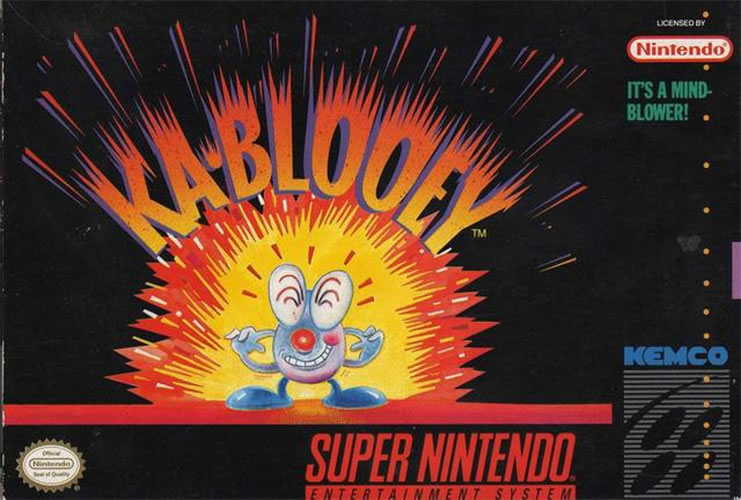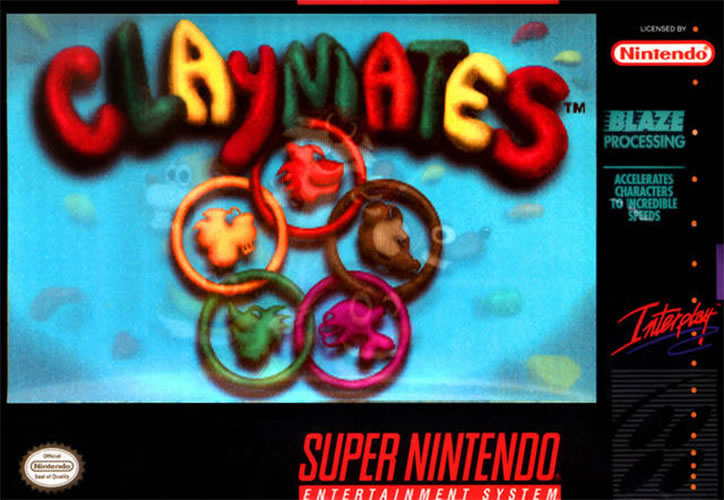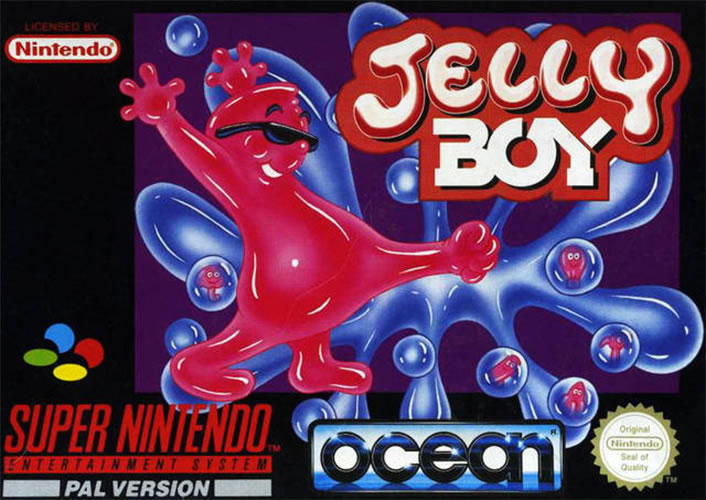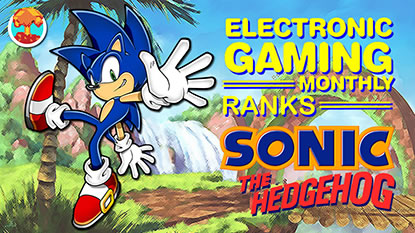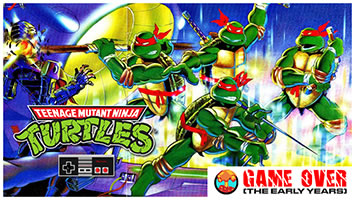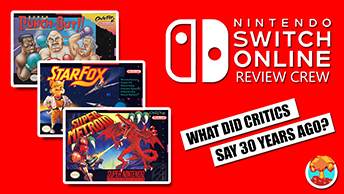- CLASSIC MAGAZINES
- REVIEW CREW
A show recapping what critics thought back
when classic games first came out! - NEXT GENERATION'S BEST & WORST
From the worst 1-star reviews to the best
5-stars can offer, this is Next Generation! - NINTENDO POWER (ARCHIVE)
Experience a variety of shows looking at the
often baffling history of Nintendo Power! - MAGAZINE RETROSPECTIVE
We're looking at the absolutely true history of
some of the most iconic game magazines ever! - SUPER PLAY'S TOP 600
The longest and most ambitious Super NES
countdown on the internet! - THEY SAID WHAT?
Debunking predictions and gossip found
in classic video game magazines! - NEXT GENERATION UNCOVERED
Cyril is back in this spin-off series, featuring the
cover critic review the art of Next Generation! - HARDCORE GAMER MAGAZING (PDF ISSUES)
Download all 36 issues of Hardcore Gamer
Magazine and relive the fun in PDF form!
- REVIEW CREW
- ELECTRONIC GAMING MONTHLY
- ELECTRONIC GAMING MONTHLY RANKS
From Mario to Sonic to Street Fighter, EGM
ranks classic game franchises and consoles! - ELECTRONIC GAMING MONTHLY BEST & WORST
Counting down EGM’s best and worst reviews
going year by year, from 1989 – 2009! - ELECTRONIC GAMING BEST & WORST AWARDS
11-part video series chronicling the ups and
downs of EGM’s Best & Worst Awards!
- ELECTRONIC GAMING MONTHLY RANKS
- GAME HISTORY
- GAME OVER: STORY BREAKDOWNS
Long-running series breaking down game
stories and analyzing their endings! - A BRIEF HISTORY OF GAMING w/ [NAME HERE]
Real history presented in a fun and pithy
format from a variety of game historians! - THE BLACK SHEEP
A series looking back at the black sheep
entries in popular game franchises! - INSTANT EXPERT
Everything you could possibly want to know
about a wide variety of gaming topics! - FREEZE FRAME
When something familiar happens in the games
industry, we're there to take a picture! - I'VE GOT YOUR NUMBER
Learn real video game history through a series
of number-themed episodes, starting at zero! - GREAT MOMENTS IN BAD ACTING
A joyous celebration of some of gaming's
absolute worst voice acting!
- GAME OVER: STORY BREAKDOWNS
- POPULAR SHOWS
- DG NEWS w/ LORNE RISELEY
Newsman Lorne Riseley hosts a regular
series looking at the hottest gaming news! - REVIEW REWIND
Cyril replays a game he reviewed 10+ years
ago to see if he got it right or wrong! - ON-RUNNING FEUDS
Defunct Games' longest-running show, with
editorials, observations and other fun oddities! - DEFUNCT GAMES QUIZ (ARCHIVE)
From online quizzes to game shows, we're
putting your video game knowledge to the test!- QUIZ: ONLINE PASS
Take a weekly quiz to see how well you know
the news and current gaming events! - QUIZ: KNOW THE GAME
One-on-one quiz show where contestants
find out if they actually know classic games! - QUIZ: THE LEADERBOARD
Can you guess the game based on the classic
review? Find out with The Leaderboard!
- QUIZ: ONLINE PASS
- DEFUNCT GAMES VS.
Cyril and the Defunct Games staff isn't afraid
to choose their favorite games and more! - CYRIL READS WORLDS OF POWER
Defunct Games recreates classic game
novelizations through the audio book format!
- DG NEWS w/ LORNE RISELEY
- COMEDY
- GAME EXPECTANCY
How long will your favorite hero live? We crunch
the numbers in this series about dying! - VIDEO GAME ADVICE
Famous game characters answer real personal
advice questions with a humorous slant! - FAKE GAMES: GUERILLA SCRAPBOOK
A long-running series about fake games and
the people who love them (covers included)! - WORST GAME EVER
A contest that attempts to create the worst
video game ever made, complete with covers! - LEVEL 1 STORIES
Literature based on the first stages of some
of your favorite classic video games! - THE COVER CRITIC
One of Defunct Games' earliest shows, Cover
Critic digs up some of the worst box art ever! - COMMERCIAL BREAK
Take a trip through some of the best and
worst video game advertisements of all time! - COMIC BOOK MODS
You've never seen comics like this before.
A curious mix of rewritten video game comics!
- GAME EXPECTANCY
- SERIES ARCHIVE
- NINTENDO SWITCH ONLINE ARCHIVE
A regularly-updated list of every Nintendo
Switch Online release, plus links to review! - PLAYSTATION PLUS CLASSIC ARCHIVE
A comprehensive list of every PlayStation
Plus classic release, including links! - RETRO-BIT PUBLISHING ARCHIVE
A regularly-updated list of every Retro-Bit
game released! - REVIEW MARATHONS w/ ADAM WALLACE
Join critic Adam Wallace as he takes us on a
classic review marathon with different themes!- DEFUNCT GAMES GOLF CLUB
Adam Wallace takes to the links to slice his way
through 72 classic golf game reviews! - 007 IN PIXELS
Adam Wallace takes on the world's greatest spy
as he reviews 15 weeks of James Bond games! - A SALUTE TO VAMPIRES
Adam Wallace is sinking his teeth into a series
covering Castlevania, BloodRayne and more! - CAPCOM'S CURSE
Adam Wallace is celebrating 13 days of Halloween
with a line-up of Capcom's scariest games! - THE FALL OF SUPERMAN
Adam Wallace is a man of steel for playing
some of the absolute worst Superman games! - THE 31 GAMES OF HALLOWEEN
Adam Wallace spends every day of October afraid
as he reviews some of the scariest games ever! - 12 WEEKS OF STAR TREK
Adam Wallace boldly goes where no critic has
gone before in this Star Trek marathon!
- DEFUNCT GAMES GOLF CLUB
- DAYS OF CHRISTMAS (ARCHIVE)
Annual holiday series with themed-episodes
that date all the way back to 2001!- 2015: 30 Ridiculous Retro Rumors
- 2014: 29 Magazines of Christmas
- 2013: 29 Questionable Power-Ups of Christmas
- 2012: 34 Theme Songs of Christmas
- 2011: 32 Game Endings of Christmas
- 2010: 31 Bonus Levels of Christmas
- 2009: 30 Genres of Christmas
- 2008: 29 Controls of Christmas
- 2007: 34 Cliches of Christmas
- 2006: 33 Consoles of Christmas
- 2005: 32 Articles of Christmas
- 2004: 31 Websites of Christmas
- 2003: 29 Issues of Christmas
- 2002: 28 Years of Christmas
- 2001: 33 Days of Christmas
- NINTENDO SWITCH ONLINE ARCHIVE
- REVIEW ARCHIVE
- FULL ARCHIVE
Nintendo Switch Online: 1990s Critics Review Bombuzal, Claymates & Jelly Boy
This just in: Nintendo has released three new classic games onto their Nintendo Switch Online service today. These include controversial picks like Bombuzal, Jelly Boy and Claymates, all of which have been met with an aggressively negative response on social media. Is the anger warranted, or are these hidden 16-bit gems just waiting to be discovered by a new generation? In order to answer that question, we're going to take a look back at what the critics said when these games were first released. Join me as I flip through the pages of Electronic Gaming Monthly, GamePro, Super Play and more classic magazines in this newest episode of Nintendo Switch Online Review Crew.
Ever since the Nintendo Switch Online games were announced, I've seen a lot of people on social media arguing whether this month's titles are hidden gems or total trash. I suspect a lot of the back-and-forth can be pinned on our first game, Bombuzal, which is certainly the most divisive title we're going to talk about today. What at first appears to be a simple puzzle game about blowing up ice has always been one of the most polarizing 16-bit games of all time, something that continues online thanks to Twitter.
The critics were sharply divided back in the day, with GamePro loving it and Electronic Gaming Monthly hating it. We'll get to what EGM said in a moment, but let's first focus on the positive. When GamePro reviewed Bombuzal (or, Kablooey, as it was known here in the United States), they gave it a 4 out of 5 and concluded that "Nice graphics combine with an engaging series of puzzles to challenge even the most spacially oriented of gamers. Apply some brain cells to this game and prove you're the king pin of krafty gaming."
Electronic Gaming Monthly, on the other hand, was not nearly as kind to Bombuzal. In fact, with a score a 3.5 out of 10, it's the magazine's worst-reviewed Super NES game. It was so forgettable that they didn't even bother giving it a Review Crew column, instead sticking the write-up in a special Super NES buyers' guide section found in issue 25. They described it as "one of the first Super NES carts directed at a younger audience, as well as the first with a puzzle theme." However, they were miffed that it "does not make good use of the Super NES hardware." Aside from that, they weren't as critical as you would expect, especially given the rock-bottom score. This is definitely one of those situations where the review average is a lot worse than the review text.
If you're for some sort of middle ground, the closest we get is Nintendo Power. With a score of 2.8 out of 5, it's not nearly as positive as GamePro, but clearly not as negative as EGM. George liked the graphics, but found the character to be frustrating to control and the puzzles too challenging. Rob concluded that he liked the name more than the game. "There's not much else that I can say in its favor." Yikes. With scores ranging from good to terrible, Bombuzal has always been (and will continue to be) one of the most divisive games of the 16-bit era.
For an all-too-brief moment in the 1990s, companies like Interplay and Midway were trying to pair video games with Claymation. The most popular franchise to come out of this trend was Clay Fighters, but there was another game that came at almost exactly the same time that might be even better. I'm of course talking about Claymates, a colorful platformer with a likeable cast of animal heroes and a name so bad that I'm pretty sure they only used it so that the ads could poke fun of Playboy. Just what you want from your cute and adorable kids' game.
While it may have a terrible name, Claymates is the month's best-reviewed game. Don't get me wrong, none of the critic necessarily loved it, but with scores in the 7 and 8 range, the reviews were a lot more consistent than either Bombuzal or Jelly Boy. GamePro once again gave it the highest score, concluding that Claymates "was cut from the right mold." "Have you already powered past Super Mario? Did you beat Bubsy? If you're looking for your next platform cart, Claymates is a good playmate."
Electronic Gaming Monthly also liked the game, but not enough to give it a proper Review Crew column. Letting Mike Weigand write a consensus review, he explained that "Claymates is a cute side-scrolling action game that exceeds in graphics, and having tons of hidden items is a real treat." With Al bringing the average down a bit, Claymates earned a 7 out of 10 from EGM.
We saw a similar reaction from Super Play over in the UK. Giving it a 79%, they called it "fun and gimmicky," but complained that the game was "let down by glaringly horrible bits. The availability of infinite continues means it's over far too quickly, but there's plenty here to play around with." The full review praises the game for having a nice variety and a wealth of original ideas, all of which will most likely work in Claymates' favor when you check it out on the Switch.
From a strictly American perspective, Jelly Boy is the most intriguing retro release coming to the Switch this month. That's because this 1995 platformer was never released outside of Europe, making it a brand new 16-bit experience for most of us in the States. But just because it's new, does that make it good? The answer to that question is not as simple as it sounds.
With no American release, Jelly Boy obviously didn't get a review from the usual suspects, like EGM, GamePro, Next Generation and Game Fan. The good news is that the UK-based magazines have us covered. The bad news is that this review from Super Play leaves me with more questions than answers: "Inspired, beautiful and exciting. All words which are as applicable to Jelly Boy as dainty is to Cyril Smith's Y-fronts. Look elsewhere for a good solid platformer." With a score of 61%, it's clear that Tony Mott didn't think much of this game. But who is Cyril Smith? And what are his Y-fronts? I definitely need one of our wonderful British viewers to translate that feels like it's supposed to be a sick burn.
Mean Machines Sega disagreed with Super Play's low score, giving the Mega Drive version of Jelly Boy an impressive 90%. Gus called the game a "true classic," arguing this unassuming platformer was deceptively awesome. It may look like a generic action game, "but playing actually reveals an achingly addictive and vast adventure that scores entirely on the ingenuity of its levels. Jelly Boy's a game you'll keep reaching for." There's just one problem: You couldn't actually reach for it. At least, not the Mega Drive version. It was canceled right before release, but apparently not before Mean Machines Sega wrote their review. Thankfully, the Super NES version came out, and American gamers will finally have a chance to play it on the Switch.
| Publication | Scores |
|---|---|
| GamePro | 4/5 |
| Electronic Gaming Monthly | 3.5/10 |
| Next Generation | 3/5 |
| Nintendo Power | 2.8/5 |
| AVERAGE SCORE | 53% |
The critics were sharply divided back in the day, with GamePro loving it and Electronic Gaming Monthly hating it. We'll get to what EGM said in a moment, but let's first focus on the positive. When GamePro reviewed Bombuzal (or, Kablooey, as it was known here in the United States), they gave it a 4 out of 5 and concluded that "Nice graphics combine with an engaging series of puzzles to challenge even the most spacially oriented of gamers. Apply some brain cells to this game and prove you're the king pin of krafty gaming."
Electronic Gaming Monthly, on the other hand, was not nearly as kind to Bombuzal. In fact, with a score a 3.5 out of 10, it's the magazine's worst-reviewed Super NES game. It was so forgettable that they didn't even bother giving it a Review Crew column, instead sticking the write-up in a special Super NES buyers' guide section found in issue 25. They described it as "one of the first Super NES carts directed at a younger audience, as well as the first with a puzzle theme." However, they were miffed that it "does not make good use of the Super NES hardware." Aside from that, they weren't as critical as you would expect, especially given the rock-bottom score. This is definitely one of those situations where the review average is a lot worse than the review text.
If you're for some sort of middle ground, the closest we get is Nintendo Power. With a score of 2.8 out of 5, it's not nearly as positive as GamePro, but clearly not as negative as EGM. George liked the graphics, but found the character to be frustrating to control and the puzzles too challenging. Rob concluded that he liked the name more than the game. "There's not much else that I can say in its favor." Yikes. With scores ranging from good to terrible, Bombuzal has always been (and will continue to be) one of the most divisive games of the 16-bit era.
| Publication | Scores |
|---|---|
| GamePro | 4/5 |
| Super Play | 79% |
| Electronic Gaming Monthly | 7/10 |
| Nintendo Power | 3.5/5 |
| AVERAGE SCORE | 75% |
While it may have a terrible name, Claymates is the month's best-reviewed game. Don't get me wrong, none of the critic necessarily loved it, but with scores in the 7 and 8 range, the reviews were a lot more consistent than either Bombuzal or Jelly Boy. GamePro once again gave it the highest score, concluding that Claymates "was cut from the right mold." "Have you already powered past Super Mario? Did you beat Bubsy? If you're looking for your next platform cart, Claymates is a good playmate."
Electronic Gaming Monthly also liked the game, but not enough to give it a proper Review Crew column. Letting Mike Weigand write a consensus review, he explained that "Claymates is a cute side-scrolling action game that exceeds in graphics, and having tons of hidden items is a real treat." With Al bringing the average down a bit, Claymates earned a 7 out of 10 from EGM.
We saw a similar reaction from Super Play over in the UK. Giving it a 79%, they called it "fun and gimmicky," but complained that the game was "let down by glaringly horrible bits. The availability of infinite continues means it's over far too quickly, but there's plenty here to play around with." The full review praises the game for having a nice variety and a wealth of original ideas, all of which will most likely work in Claymates' favor when you check it out on the Switch.
| Publication | Scores |
|---|---|
| Mean Machines Sega | 90% |
| Super Play | 61% |
| AVERAGE SCORE | 76% |
With no American release, Jelly Boy obviously didn't get a review from the usual suspects, like EGM, GamePro, Next Generation and Game Fan. The good news is that the UK-based magazines have us covered. The bad news is that this review from Super Play leaves me with more questions than answers: "Inspired, beautiful and exciting. All words which are as applicable to Jelly Boy as dainty is to Cyril Smith's Y-fronts. Look elsewhere for a good solid platformer." With a score of 61%, it's clear that Tony Mott didn't think much of this game. But who is Cyril Smith? And what are his Y-fronts? I definitely need one of our wonderful British viewers to translate that feels like it's supposed to be a sick burn.
Mean Machines Sega disagreed with Super Play's low score, giving the Mega Drive version of Jelly Boy an impressive 90%. Gus called the game a "true classic," arguing this unassuming platformer was deceptively awesome. It may look like a generic action game, "but playing actually reveals an achingly addictive and vast adventure that scores entirely on the ingenuity of its levels. Jelly Boy's a game you'll keep reaching for." There's just one problem: You couldn't actually reach for it. At least, not the Mega Drive version. It was canceled right before release, but apparently not before Mean Machines Sega wrote their review. Thankfully, the Super NES version came out, and American gamers will finally have a chance to play it on the Switch.
HOME |
CONTACT |
NOW HIRING |
WHAT IS DEFUNCT GAMES? |
NINTENDO SWITCH ONLINE |
RETRO-BIT PUBLISHING
Retro-Bit |
Switch Planet |
The Halcyon Show |
Same Name, Different Game |
Dragnix |
Press the Buttons
Game Zone Online | Hardcore Gamer | The Dreamcast Junkyard | Video Game Blogger
Dr Strife | Games For Lunch | Mondo Cool Cast | Boxed Pixels | Sega CD Universe | Gaming Trend
Game Zone Online | Hardcore Gamer | The Dreamcast Junkyard | Video Game Blogger
Dr Strife | Games For Lunch | Mondo Cool Cast | Boxed Pixels | Sega CD Universe | Gaming Trend
Copyright © 2001-2024 Defunct Games
All rights reserved. All trademarks are properties of their respective owners.
All rights reserved. All trademarks are properties of their respective owners.







